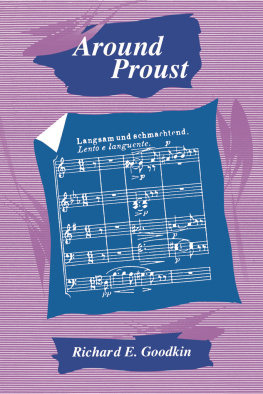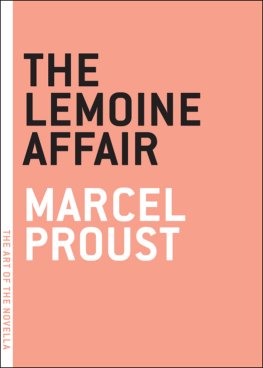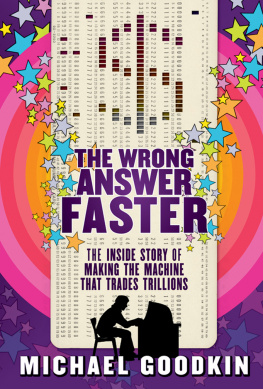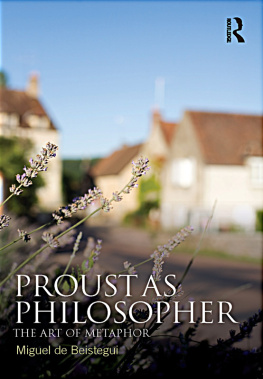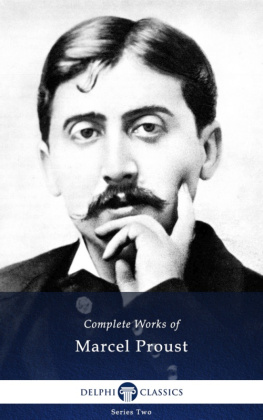Richard E. Goodkin - Around Proust
Here you can read online Richard E. Goodkin - Around Proust full text of the book (entire story) in english for free. Download pdf and epub, get meaning, cover and reviews about this ebook. year: 2022, publisher: Princeton UP, genre: Detective and thriller. Description of the work, (preface) as well as reviews are available. Best literature library LitArk.com created for fans of good reading and offers a wide selection of genres:
Romance novel
Science fiction
Adventure
Detective
Science
History
Home and family
Prose
Art
Politics
Computer
Non-fiction
Religion
Business
Children
Humor
Choose a favorite category and find really read worthwhile books. Enjoy immersion in the world of imagination, feel the emotions of the characters or learn something new for yourself, make an fascinating discovery.
- Book:Around Proust
- Author:
- Publisher:Princeton UP
- Genre:
- Year:2022
- Rating:5 / 5
- Favourites:Add to favourites
- Your mark:
- 100
- 1
- 2
- 3
- 4
- 5
Around Proust: summary, description and annotation
We offer to read an annotation, description, summary or preface (depends on what the author of the book "Around Proust" wrote himself). If you haven't found the necessary information about the book — write in the comments, we will try to find it.
Around Proust — read online for free the complete book (whole text) full work
Below is the text of the book, divided by pages. System saving the place of the last page read, allows you to conveniently read the book "Around Proust" online for free, without having to search again every time where you left off. Put a bookmark, and you can go to the page where you finished reading at any time.
Font size:
Interval:
Bookmark:

AROUND PROUST
AROUND PROUST
RICHARD E. GOODKIN
PRINCETON UNIVERSITY PRESS
PRINCETON, NEW JERSEY
Copyright 1991 by Princeton University Press
Published by Princeton University Press, 41 William Street, Princeton, New Jersey 08540
In the United Kingdom: Princeton University Press, Oxford
All Rights Reserved
Goodkin, Richard E.
Around Proust / Richard E. Goodkin
p. cm.
Includes bibliographical references and index
ISBN 0-691-06894-1 (cl)ISBN 0-691-01508-2 (pb)
1. Proust, Marcel, 1871-1922. A la recherche du temps perdu.
2. Proust, Marcel, 1871-1922Knowledge and learning. I. Title.
PQ2631.R63A7928 1991
843'.912dc20 90-25443 CIP
Princeton University Press,
eISBN: 978-1-400-82059-7
R0
For Charlie Gillespie
1958-1991
IN LOVING MEMORY
ACKNOWLEDGMENTS
T HIS BOOK was completed during the course of a Yale University Senior Faculty Fellowship that I held in 1988-1989: my thanks to the French Department at Yale for their support. I would also like to thank the Department of French and Italian at the University of Wisconsin-Madison, where I was a Visiting Fellow during 1988-1989 and of which I am currently a member, for their generous support.
A shorter version of was given at the MLA convention in 1987 as part of a panel on Proust, and was published under the title "The Proustian Octave: Or, The Scale of Love (and Death)" in Style 22, no. 3 (Fall 1988), a special issue devoted to Proust. Thanks to John Halperin of Vanderbilt University, the chair of the panel, to Margaret Miner of Vanderbilt University for first mentioning the Tristan Chord to me in our discussions about Baudelaire and Wagner, and to Jon Bailey of Pomona College for helping me to understand some of the theoretical implications of the Tristan Chord. I am also grateful to Lauren Oppenheim of Princeton University Press for her invaluable comments and criticisms about this chapter.
Thanks are also due various teachers, friends, and students. I think in particular of Robert Roza of Swarthmore College, for the many hours he spent with me discussing my senior thesis on Proust in 1974-1975; of Annette Becker and Jean and Franoise Rueff, for helping to keep me up-to-date on public discussion of Proust in France; and of Claudia Brodsky, for her endless encouragement and wise advice. Among the dozens of students at Yale, both graduate and undergraduate, who have made teaching Proust a great pleasure and who have helped me to approach the novels from many different perspectives, several names come to mind: Myriam Boucharenc, Sarah Winter, Linda Jones, Carole Harris, Margaret Gray-McDonald, Juliann Garey, Margaret Perrow, Valerie Norton, Margit Dementi, Katherine Bonamo, and Vilashini Cooppan.
I would like to thank my family: my mother, Louise, Ira, Marie, Joseph, Kathleen, Mandel, and Roger. Without their support, patience, and love, I would never have written this book.
Finally, I would like to dedicate Around Proust to the memory of my partner and companion, Charlie Gillespie. His love, his courage, and his joy in living have been an endless source of inspiration to me.
AROUND PROUST
INTRODUCTION
To be with someone you love and to think of something else: that is how I have my best thoughts, how I best discover what is necessary for my work. It is the same thing with the text it produces in me the best sort of pleasure if it manages to make itself heard indirectly; if, in reading it, I am often led to lift my eyes from the page, to hear something else. Roland Barthes, Le Plaisir du texte
B ECAUSE THE TITLE of this book is meant to be evocative rather than explanatory, I will begin by speaking about my main goals in the present study. What I have placed "around Proust" is a wide variety of things: other literary texts, other (nonliterary) artistic forms, and other (nonartistic) modes of intellectual pursuit. Certainly the openness of Proust's monumental cycle of novels, A la recherche du temps perdu, to domains far more numerous than those included in this book has already been amply demonstrated. What I would like to do here is to use a number of these recognized connections as the starting points for a series of readings of Proust's masterpiece.
The artistic and intellectual entities I have chosen to consider in relation to Proust's cycle of novels are extremely diverse in a number of ways: chronologically, culturally, aesthetically, and epistemologically. They come from periods ranging from antiquity (Homer, Zeno of Elea) to the 1950s (Hitchcock). They belong to the cultures of the Greek, French, German, and English-speaking worlds. And they take such diverse forms as epic, lyric poetry, film, and psychological treatise. And yet in spite of their variety of medium and perspective, my premise is that at some level all of these works and theories interact with Proust's text in similar ways; their interaction can show us something complex and thought-provoking about both Proust's novel and the artistic and nonartistic forms being placed alongside it.
I hope that the analyses that follow, each of which places a work or a theory in tandem with Proust's novel, will show that Proust's textin spite of its much-commented-upon length and the impression it gives of having exhausted every topic about which it speaks (not to mention the reader)comes into its own when it is drawn out of itself. Perhaps a useful way to speak about Proust, then, is to speak "around" Proust, in conjunction with a series of literary, artistic, and intellectual "others." Proust's work most becomes itself when it is seen indirectly, "around" others.
Readers of Proust may well wonder about the value of adding anything to the three-thousand-page (or, in the new Pliade edition with its seemingly endless brouillons, four-thousand-page) cycle of novels. It is inevitable that any critical or analytical approach to a text must bring to it elements that come from outside of the text itself, but a reader struck by the unsurpassed consistency of Proust's cycle might begin to feel that if there is a work of literature that stands on its own, this is it.
A la recherche du temps perdu certainly belongs to the category of masterpieces that give the impression of being utterly self-contained, of creating a universe that, although infinitely complex, retains tremendous internal coherence. This is true whether one examines the work's largest issues or its most minute details, the role of involuntary memory or that of Thodore, the grocery boy at Combray. As the French would say, tout se tient: it all holds together. Proust even had the consideration to incorporate into his novel a discussion of what the narrator's ideal novel would be like. And whether A la recherche du temps perdu is or is not intended to be that novel, many critics have applied this self-proclaimed ars poetica, taken from the last volume of the cycle, to the work itself and found it to be the crowning element of the cycle's internal coherencewhence, perhaps, the tendency of critical works about Proust to pastiche his style, to paraphrase the analyses he himself provides in the novel, and to mimic his title. The effect of all this is to emphasize still further the novel's consistency.
This consistency, however, can be viewed from quite a different perspective; approached with even the slightest irreverence, the novel actually encourages us to do so. The consistency of the novel can be taken as a function of its obsessiveness, of its narrator's inability ever to break out of himself. Like the young Marcel so intent on his good-night kiss that he appears on the verge of imploding, the novel has a strong, almost irresistible centripetal force that draws all concerns toward itself and expresses them in its own terms. And although the novel tells us again and again that obsessiveness is the human condition, it also reminds us of the limiting nature of obsession.
Font size:
Interval:
Bookmark:
Similar books «Around Proust»
Look at similar books to Around Proust. We have selected literature similar in name and meaning in the hope of providing readers with more options to find new, interesting, not yet read works.
Discussion, reviews of the book Around Proust and just readers' own opinions. Leave your comments, write what you think about the work, its meaning or the main characters. Specify what exactly you liked and what you didn't like, and why you think so.

